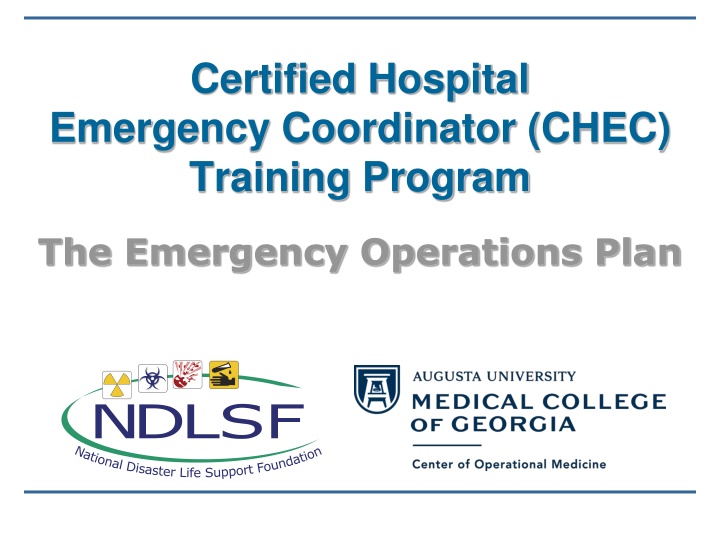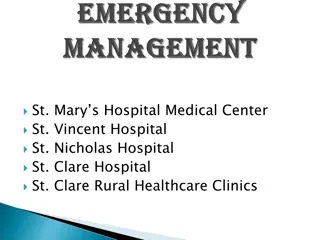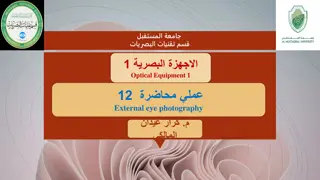
Hospital Emergency Coordinator Training Program Overview
Learn about the Certified Hospital Emergency Coordinator (CHEC) Training Program objectives, including understanding Emergency Operations Plans (EOP), Integrated Incident Management System (IIMS) tools, and mutual aid agreements. Discover the importance of EOPs, their components, and how they coordinate emergency responses within healthcare organizations.
Download Presentation

Please find below an Image/Link to download the presentation.
The content on the website is provided AS IS for your information and personal use only. It may not be sold, licensed, or shared on other websites without obtaining consent from the author. If you encounter any issues during the download, it is possible that the publisher has removed the file from their server.
You are allowed to download the files provided on this website for personal or commercial use, subject to the condition that they are used lawfully. All files are the property of their respective owners.
The content on the website is provided AS IS for your information and personal use only. It may not be sold, licensed, or shared on other websites without obtaining consent from the author.
E N D
Presentation Transcript
Certified Hospital Emergency Coordinator (CHEC) Training Program The Emergency Operations Plan
Certified Hospital Emergency Coordinator (CHEC) Training Program Objectives Upon lesson completion, you should be able to: Understand the development of the EOP Review the key components of the Emergency Operations Plan (EOP) Name important EOP evaluation activities, including exercises and after action reporting Understand what an Emergency Operations Plan (EOP) is and recognize its benefits and importance
Certified Hospital Emergency Coordinator (CHEC) Training Program Objectives, continued Understand the use of the Integrated Incident Management System (IIMS) tool Identify appropriate exercise types Identify components of IIMS Discuss the role of mutual aid agreements and memoranda of understanding
Certified Hospital Emergency Coordinator (CHEC) Training Program What is an Emergency Operations Plan? EOP Overview An EOP is the critical element of the Hospital Emergency Management Program (HEMP) Based on a well-considered HVA Is required by TJC, DNV and is now required under the recently revised CMS Conditions of Participation
Certified Hospital Emergency Coordinator (CHEC) Training Program EOP Overview, continued An EOP is a living document that: Assigns responsibilities to departments and individuals for carrying out specific actions when an emergency exceeds the capability or routine responsibility of any one organization, facility, agency, or institution
Certified Hospital Emergency Coordinator (CHEC) Training Program EOP Overview, continued An EOP also: Sets up lines of authority and organizational relationships Shows how all actions will be coordinated Describes how people and property will be protected in emergencies and disasters
Certified Hospital Emergency Coordinator (CHEC) Training Program EOP Overview, continued Additionally, an EOP Identifies personnel, equipment, facilities, supplies, and other resources available: Within the hospital and Among community partners
Certified Hospital Emergency Coordinator (CHEC) Training Program EOP Overview, continued An EOP also: Identifies steps for mitigation during planning, response, and recovery activities Cites its regulatory basis and institutional approval
Certified Hospital Emergency Coordinator (CHEC) Training Program Benefits of Having an EOP? An EOP supports organizational operations and continuation of care while protecting the organization s staff and facilities by: Ensuring a set period of predictable behavior following an emergency Providing specific guidelines Establishing a team of people to manage the situation Arranging for expert consultation and support
Certified Hospital Emergency Coordinator (CHEC) Training Program EOP Creation and Maintenance An EOP is developed with the involvement of the hospital s leaders and community partners The partners should serve on a Hospital Emergency Management Committee (HEMC) which develops the overarching Hospital Emergency Management Program (HEMP)
Certified Hospital Emergency Coordinator (CHEC) Training Program What s in an Emergency Operations Plan? EOP elements and prerequisites The EOP should: Outline the organization s strategy for responding to, and recovering from, any hazard or incident Focus on providing overall direction, control, and coordination structures and processes to be used by the facility
Certified Hospital Emergency Coordinator (CHEC) Training Program EOP Elements An EOP must address all of the following: Administration and Planning Logistics and Finance Business Operations Equipment and Utilities Operations Safety and Security Operations Health and Medical Operations
Certified Hospital Emergency Coordinator (CHEC) Training Program The Basic Plan: Key Components/Sections Statement of Purpose Situations and Assumptions Organization and Assignment of Responsibilities Administration and Logistics Plan Development and Maintenance Authorities and References Definition of Terms Annexes and Appendices Conducting exercises Hazard Vulnerability Analysis (HVA)
Certified Hospital Emergency Coordinator (CHEC) Training Program Key Components/Sections: Statement of Purpose Describes the purpose simply and understandably to all readers It should convey that an EOP is meant to: Provide for the effective and efficient management of disasters Yield acceptable assistance and protection of life and property
Certified Hospital Emergency Coordinator (CHEC) Training Program Key Components/Sections: Situations and Assumptions Describes the types of disasters and emergency situations which may occur Based on the Hazard Vulnerability Analysis (HVA)
Certified Hospital Emergency Coordinator (CHEC) Training Program Key Components/Sections: Organization & Assignment of Responsibilities Defines roles of officials in the emergency management structure Describes roles, relationships, and interactions and assignments of staff Creates lines of authority between various departments Allows for expansion of duties based on need Alternate roles for staff during emergencies To the extent possible, personnel should work with the supervisor and associates they work with regularly
Certified Hospital Emergency Coordinator (CHEC) Training Program Key Components/Sections: Administration and Logistics Addresses resource management and support requirements: Decontamination Alternate sources of utilities Backup methods of communication Staff identification Relocation, evacuation, and alternate care sites Management of patient care activity Notification of staff, patients, families, and external partners and authorities
Certified Hospital Emergency Coordinator (CHEC) Training Program Key Components/Sections: Plan Development and Maintenance Establishes provisions for review, modification, acceptance, and approval of the plan Processes for implementation Community emergency planning, working with external partners Continual reassessment and incorporation of lessons learned
Certified Hospital Emergency Coordinator (CHEC) Training Program Key Components/Sections: Authorities and References Cites the authorities and references providing the basis for the EOP, including: Statutes, executive orders, regulations, and formal agreements General planning guidance/source materials, such as plans from other agencies and hospitals
Certified Hospital Emergency Coordinator (CHEC) Training Program Key Components/Sections: Definition of Terms Defines lesser used or poorly understood terms as well as all acronyms used in the plan Class exercise: List some terms and acronyms which should be included in this section of the plan. Be mindful of the alphabet soup with which emergency managers communicate. If the people who make and serve the chicken soup can t understand those terms, they must be defined!
Certified Hospital Emergency Coordinator (CHEC) Training Program Key Components/Sections: Annexes to the Basic Plan Describe operations for particular functions An Annex is action oriented It is written for, and preferably by, the person responsible for controlling resources during disaster or emergency response
Certified Hospital Emergency Coordinator (CHEC) Training Program Key Components/Sections: Procedures and Other Attachments Procedures and operational information to support and provide direction to disaster response personnel Attachments may include: Checklists, charts, and maps Standard operating procedures Catalogues of resources Call up lists Contact lists
Certified Hospital Emergency Coordinator (CHEC) Training Program Key Components/Sections: Conducting Exercises and Training All staff must be educated on the contents of the EOP, when and for what it is used, and what roles they will play when the plan is deployed Exercises of the plan are required, as is staff participation TJC standards dictate the number of exercises required annually (with stipulations) After action reports (AARs) are essential to quality improvement of the EOP
Certified Hospital Emergency Coordinator (CHEC) Training Program Homeland Security Exercise Evaluation Program (HSEEP) Exercises Types Conduct Discussion- Based Exercise Seminars Workshops Tabletop Games Setup Presentation Facilitated discussion Moderated discussion Wrap-up activities Operations- Based Exercise Drills Functional Full-Scale Setup Exercise participants Briefings Exercise play Wrap-up activities
Certified Hospital Emergency Coordinator (CHEC) Training Program Types of Exercises: Discussion Based Can be used to familiarize participants with current plans, policies, agreements, and procedures; for example: Seminars- are informal discussions, designed to orient participants to new/updated plans, policies, or procedures Workshops- resemble seminars, but are employed to build specific products, such as a draft
Certified Hospital Emergency Coordinator (CHEC) Training Program Types of Exercises: Discussion Based Tabletops- involve key personnel discussing simulated scenarios in an informal setting Games- are simulations of operations that often involve 2 or more teams, usually in a competition, using rules, data, and procedures designed to represent an actual situation
Certified Hospital Emergency Coordinator (CHEC) Training Program Types of Exercises: Operations Based Can be used to validate plans, policies, agreements, and procedures, to clarify roles and responsibilities and to identify resource gaps in an operational environment; for example: Drills- are coordinated, supervised activities usually employed to test a single, specific operation or function within a single entity
Certified Hospital Emergency Coordinator (CHEC) Training Program Types of Exercises: Operations Based Functional- examines and/or validates the coordination, command, and control between various multi-agency coordination centers (e.g., EOC). A functional exercise does not involve deployment of assets" Full-Scale- a multi-agency, multi- jurisdictional, multi-discipline exercise involving functional and actual "deployment of assets response
Certified Hospital Emergency Coordinator (CHEC) Training Program After Action Reports (AARs) AARs are reports of information gathered during (and critiques made after) drills, exercises, and actual responses AARs are the basis of lessons learned and should be used to revise plans as a method of continuous quality improvement
Certified Hospital Emergency Coordinator (CHEC) Training Program After Action Report Production A4 step process to prepare the AAR is as follows: 1)Compile the results, and sort the information 2)Review and analyze the information 3)Prepare AAR drafts, and distribute for review and approval 4)Compile final after action report, and forward
Certified Hospital Emergency Coordinator (CHEC) Training Program Improvement Plan (IP) IPs should be developed after completion of the AAR and should reflect lessons learned For each of the principal recommendations, the IP should include: A plan of action for implementing improvements Associated costs and budgetary requirements or restrictions Timetable for completion Follow-up responsibility
Certified Hospital Emergency Coordinator (CHEC) Training Program Class Exercise Discuss template AAR forms that you use or would like to use Discuss any commercially available products that integrate AAR and IP documentation
Certified Hospital Emergency Coordinator (CHEC) Training Program Bottom Line: Characteristics of a Quality EOP Includes course of action to be taken during emergency response to ensure the health and safety of staff and patients throughout Based on valid facts or reasonable assumptions Coordinates with necessary agencies and external partners
Certified Hospital Emergency Coordinator (CHEC) Training Program Bottom Line: Characteristics of a Quality EOP Defines a clear organizational structure, including relationships, roles, and responsibilities Is written in simple language Contains elements that coordinate and fit well together Provides a mechanism for continuous evaluation and improvement
Certified Hospital Emergency Coordinator (CHEC) Training Program Integrated Incident Management System (IIMS) Following the events of September 11, 2001, the Department of Justice (DOJ), National Institute of Justice (NIJ)/Office of Science and Technology (OS&T) conducted an evaluation of what is now known industry-wide as Integrated Incident Management System or IIMS
Certified Hospital Emergency Coordinator (CHEC) Training Program Criteria for IIMS Affordable User-friendly Easy to maintain adaptable to conditions and policies agencies Allow for remote access Comply with the provisions and standards for ICS Comply with the provisions of ESFs
Certified Hospital Emergency Coordinator (CHEC) Training Program Criteria for IIMS, continued Integrate with other systems (mapping, other IIMS, and telephonic alert notification systems) Integrate public health into emergency management Operate within a variety of network configurations Have a wide range of features Offer help desk support 24/7
Certified Hospital Emergency Coordinator (CHEC) Training Program Discussion Who has used one of these systems in either an emergency or an exercise?
Certified Hospital Emergency Coordinator (CHEC) Training Program We re all in this together When you can t do it alone: Mutual Aid Agreements Memoranda of Understanding
Certified Hospital Emergency Coordinator (CHEC) Training Program Mutual Aid Agreements Mutual aid is an agreement among emergency responders to lend assistance across jurisdictional boundaries, by furnishing personnel and equipment This may occur due to an emergency that exceeds local resources, such as a disaster or a multiple-alarm fire, it may be ad hoc, requested only when such an emergency occurs It may also be a formal standing agreement for cooperative emergency management on a continuing basis May also be verbal Are typically legally binding, but it depends on the nature of the agreement
Certified Hospital Emergency Coordinator (CHEC) Training Program Mutual Aid Agreements, continued FEMA, through the Stafford Act, reimburses mutual aid agreement costs associated with emergency assistance provided all of the following are met: 1. The assistance requested by the applicant is directly related to the disaster and is eligible for FEMA assistance. 2.The mutual aid agreement is in written form and signed by authorized officials of the agreeing parties prior to the disaster.
Certified Hospital Emergency Coordinator (CHEC) Training Program Mutual Aid Agreements, continued 3. The agreement applies uniformly in emergency situations. The agreement must not be contingent upon a declaration of a major disaster or emergency by the Federal government or on receiving Federal funds. 4. The providing entity may not request or receive grant funds directly. Only the eligible applicant receiving the aid may request grant assistance. 5. Upon request, the applicant must be able to provide FEMA with documentation that the services were requested.
Certified Hospital Emergency Coordinator (CHEC) Training Program Mutual Aid Agreements, continued 6. Criterion 4 indicates that hospitals that have incurred costs through assisting other hospitals can retrieve those costs through obtaining monies disbursed to the hospital receiving the aid 7. More information on the perspective of FEMA toward mutual aid agreements is located at the FEMA website: www.fema.gov
Certified Hospital Emergency Coordinator (CHEC) Training Program Memoranda of Understanding (MOU) Definition: Document that expresses mutual accord on an issue between two or more parties, indicating an intended common line of action, rather than a legal commitment. MOUs are generally recognized as binding, even if no legal claim could be based on the rights and obligations laid down in them
Certified Hospital Emergency Coordinator (CHEC) Training Program MOU, continued To be legally operative, a MOU must: identify the contracting parties, spell out the subject matter of the agreement and its objectives, summarize the essential terms of the agreement, and, must be signed by the contracting parties
Certified Hospital Emergency Coordinator (CHEC) Training Program Consider Your EOP What changes need to be made to your EOP? What kind of training and exercise need to be done at your facility? How can you improve on your current plan? Do you have sufficient mutual aid partners and MOUs?
Certified Hospital Emergency Coordinator (CHEC) Training Program The Emergency Operations Plan Questions?






















